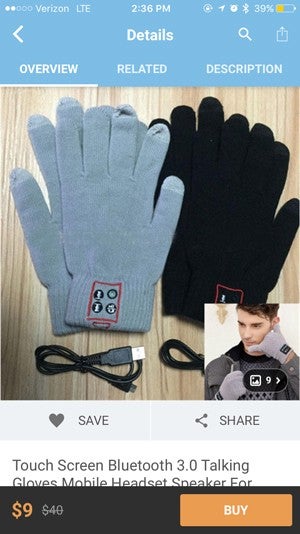The internet is very good at helping consumers find (and eventually buy) the “best” thing: the best phone, the best car, the best toilet paper, the best book. Mixing human-penned ratings with complicated algorithms, their goal is to get you to come back for more. But beyond popular online stores like Amazon, there is, as John Herrman wrote for Matter, an entire other world out there: “I’ve been living happily in an electronics shitworld long enough that I’ve begun evangelizing for it,” he wrote about his impossibly cheap, $80 Android smartphone made by a company you’ve never heard of and shipped from across the globe.
These shit-electronics — usually made in anonymous factories in Shenzhen or other Chinese manufacturing centers — do not bear the gilded brand names of trusted American, Japanese or South Korean companies. But they are made from many of the same parts, in many of the same configurations—released with no fanfare and little quality control.
And they sort of work, sometimes at least.
Until recently, these shit-products (not just electronics but pretty much anything else you could imagine) have been somewhat tricky to find, existing about a dozen pages into Amazon search results or in the rowdy, digital auction house that is eBay. So when Wish, a new shopping app created by engineers Peter Szulczewski and Danny Zhang that has raised $600 million from investors, began advertising (incredibly heavily, mind you!) on Instagram and Facebook, I’m sure some people thought, How can a smartwatch possibly cost $11? Why is it being sold next to a pair of tight men’s harem pants with cargo pockets and a pair of knock-off Yeezy sneakers? Who in the world would buy a gigantic thumb ring that doubles as a bottle opener?
But I’ve spent enough time in the shit-world to know a portal when I see one.
That’s why Wish is my favorite app. It’s a complete mess of items—ranging from probably-illegal counterfeit clothes ($12) to a microfiber towel that straps onto your hand like a plush skin growth ($2) to an 8-inch “big black fresh brown” dildo ($7) to a commemorative Paul Walker bumper sticker ($2) to a pair of underwear so perfectly described by the title that I’ll just paste it here: “Amazing Mens Sexy Bikini Thong Underwear Underpants Smooth Long Bulge Pouch Boxers Nightwear Briefs Shorts Casual Slim Fit” ($7).
There’s practically nothing you can’t find on Wish.

Nothing is perfect. Some of it is probably adequate, and anyone who buys from Wish knows that they’re taking a risk. Shipping is incredibly slow, taking about a month to get from wherever to your front doorstep. I assume customer service is nonexistent (although I’ve never bothered to try contacting them). I’ve since spent hours browsing through this garbage, spending probably $50 on 15 different items, and honestly, if they never show up I’ll still feel like I got my money’s worth. (This is not unlikely; customers sometimes report that items show up broken or that the items that arrive are not the ones they ordered.) But that’s what you get for ordering a $12 prom dress.
That said, about three to four weeks after I discovered the app and began spending very small amounts of money on garbage, some of the garbage began showing up on my doorstep. It ranges in quality: an iPhone case that looks like a bottle of Absolut vodka ($1) is saved from copyright infringement only because all of the text is misspelled. (“Countiy of sweden,” it reads.) A pair of shiny gold men’s hotpants ($3) is made of a material that Party City would deem too cheap-feeling for a “Sexy Donald Trump” Halloween costume.

But the best thing I unpacked is an anonymously-branded smartwatch ($12), which, against all odds, actually works. It can only sync to my iPhone in a limited way — getting texts and emails is apparently restricted to Android phones — but I can make and receive calls, use a pedometer and a stopwatch, listen to music through a tiny, tiny speaker, and set an alarm. It’s not as good as an Apple Watch, but let’s be real: the Apple Watch only gives about $12 worth of enjoyment anyway. Smartwatches are, at the moment, very stupid, but at least with this thing I’m getting a decent deal!
Re/code recently called Wish “the next Walmart,” reporting that the app had secured a huge amount of money from investors, taking “the direct-to-consumer fad to the extreme [by] connecting buyers directly to Chinese manufacturers who ship to customer’s doors from factories, cutting out middlemen and markups along the way.”
Shit-merch has been bubbling up in the tech world for years now—with anonymous hardware manufacturers realizing that the pace of development is so fast that last month’s or last year’s product is still perfectly fine, or that customers are willing to forego certain luxuries (customer service, say, or a manual written in English) in exchange for steep discounts. The “shit” version of whatever is good enough, in a lot of cases.
And even when it’s not, just the act of browsing through Wish is a whirlwind experience, giving me the same addictive, tunnel vision I get while browsing Vine. Thanks to Wish, I can get lost in the back alleys of Wall-Mark, scan boxes in the warehouse of Turget or find weird clothes lying on the floor of H&N.
It’s better than Twitter, that’s for sure.
Dan Nosowitz is a freelance writer and editor who has written for Popular Science, The Awl, Gizmodo, Fast Company, BuzzFeed and elsewhere.
